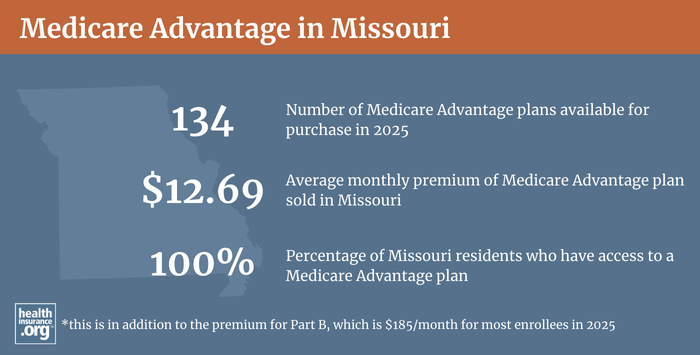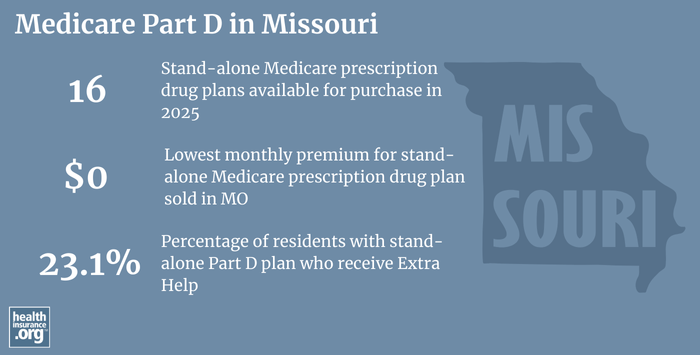Medicare in Missouri

Missouri has strong consumer protections for Medigap coverage
Key Takeaways
- Over 1.3 million residents are enrolled in Medicare in Missouri.1
- 53% of Missouri Medicare beneficiaries use a Medicare Advantage plan.1
- Residents in Missouri can select from between 10 and more than 45 Medicare Advantage plan options in 2025, depending on health plan service areas.2
- More than a million Missouri Medicare beneficiaries have Medicare Part D prescription drug coverage, either as a stand-alone plan or integrated with Medicare Advantage.1

Medicare enrollment in Missouri
Medicare enrollment in Missouri was 1,331,598 as of September 2024,1 amounting to nearly 18% of the state’s total population.3 More than 86% of Missouri Medicare beneficiaries are eligible due to being at least 65 years old, but 14% of the state’s beneficiaries — over 174,000 people1 — are eligible due to a disability that lasts at least two years (people with amyotrophic lateral sclerosis (ALS) or end-stage renal disease do not have to wait two years for Medicare enrollment).
Nationwide, about 89% of Medicare beneficiaries are eligible due to age, while about 11% are eligible due to disability.4
There’s an Annual Enrollment Period each fall (October 15 to December 7) during which people can change from Original Medicare to Medicare Advantage, or vice versa. There is also a Medicare Advantage open enrollment period (January 1 to March 31) during which people who are already enrolled in Medicare Advantage plans can switch to a different Medicare Advantage plan or drop their Medicare Advantage plan and enroll in Original Medicare instead.
Medicare options
Medicare beneficiaries have choices when it comes to how they access Medicare coverage. The first choice is between Medicare Advantage, where coverage is through private Medicare Advantage plans or Original Medicare, where medical costs are covered directly by the federal government. Medicare beneficiaries also have options around Medigap policies and Medicare Part D (prescription drug) coverage.
Original Medicare includes Part A (also called hospital insurance, which helps pay for inpatient stays, like at a hospital, skilled nursing facility, or hospice center) and Part B (also called medical insurance, which helps pay for outpatient care like a doctor appointment or a preventive healthcare service). Medicare Advantage plans bundle Medicare Parts A and B under a single monthly premium, most plans include prescription drug coverage and may offer extra benefits like vision coverage. There are pros and cons to either option, and the best solution is different for each individual.
Learn about Medicare plan options in Missouri by contacting a licensed agent.



Explore our other comprehensive guides to coverage in Missouri

We’ve created this guide to help you understand the Missouri health insurance options available to you and your family, and to help you select the coverage that will best fit your needs and budget.


Hoping to improve your smile? Dental insurance may be a smart addition to your health coverage. Our guide explores dental coverage options in Missouri.


Learn about Missouri’s Medicaid expansion, the state’s Medicaid enrollment and Medicaid eligibility.


Short-term health plans provide temporary health insurance for consumers who may find themselves without comprehensive coverage. Learn more about short-term plan availability in Missouri.

Frequently asked questions about Medicare in Missouri
What is Medicare Advantage?
About 34% of Missouri Medicare beneficiaries were enrolled in private Medicare Advantage plans in 20185 (nationwide, the average was 35% at that point).6 The remaining 66% of the state’s Medicare beneficiaries had coverage under Original Medicare.5 By September 2024, 53% of Missouri’s Medicare beneficiaries were enrolled in private coverage.1 That corresponds with the nationwide growth in Medicare Advantage enrollment: Roughly 50% of all Medicare beneficiaries nationwide were enrolled in private coverage as of September 2024.4
Missouri residents who seek Medicare Advantage enrollment can choose from a variety of different health plans. Plan availability varies from one county to another (where a given insurance company offers coverage is called its “service area.”)In some counties there are as few as 10 Medicare Advantage plans available in 2025, while other counties have more than 45 different Medicare Advantage plan options available to beneficiaries.: 2

What are Medigap plans?
Medigap policies are used to supplement Original Medicare, covering some or all of the out-of-pocket costs (for coinsurance and deductibles) that people would otherwise incur if they only had Original Medicare on its own.
There are 32 insurers that offer Medigap policies in Missouri as of 2025.7
The state created a helpful Medigap Rate Shopper Tool in 2019 that allows a user to enter some basic information and see prices for the Medigap plans available in their area (the state’s previous tool could only give a rough estimate based on age ranges).
Medigap policies are standardized under federal rules, and there is a six-month window, when people turn 65 and enroll in Original Medicare, during which coverage is guaranteed issue for Medigap plans.
But federal rules do not allow for any sort of annual open enrollment period for Medigap (like the annual open enrollment period that applies to Medicare Part D plans and Medicare Advantage plans), nor do federal rules guarantee access to a Medigap plan if you’re under 65 and eligible for Medicare as a result of a disability.
So in most states, people do not have a chance to switch to a new Medigap plan on a guaranteed-issue basis after their initial enrollment window ends. But Missouri’s “anniversary rule” allows enrollees an annual opportunity to change from one Medigap insurer to another (as long as both plans are the same letter; for example, from one Plan G to another Plan G) on a guaranteed-issue basis during a window that starts 30 days before the plan anniversary date and continues for 30 days after it.
So there’s a two-month period each year during which people with Medigap coverage can switch to a different Medigap plan (with the same coverage level as their current plan). This window is different for each enrollee, since it’s based on the date they initially got their plan.
And Missouri is among the majority of the states that have adopted rules to ensure at least some access to Medigap policies for enrollees under the age of 65. Missouri residents have access to the same six-month guaranteed-issue window for Medigap, regardless of whether they’re becoming eligible for Medicare in Missouri due to age or due to disability. The premiums are higher for enrollees under age 65, but not drastically so.
In many states, premiums are two to four times more expensive for people under 65; in Missouri, most insurers’ rates for people under 65 are not more than 35% higher than the rates that apply to people who are 65. This is because Missouri regulates how much Medigap insurers can charge under-65 enrollees: According to the terms of Missouri’s Code of State Regulations (see 20 CSR 400-3.650(11)(E)(1)(B)), under-65 Medigap rates for each insurer must be equal to the “weighted average aged premium rate.” So enrollees under the age of 65 will end up paying premiums that are higher — but not significantly higher — than the rates charged for a 65-year-old.
Medicare enrollees are given another Medigap enrollment window when they turn 65, so they can then switch to lower-cost Medigap coverage at that point.
What is Medicare Part D?
Original Medicare does not cover outpatient prescription drugs. Avenues for Medicare beneficiaries to secure needed prescription drug coverage include Medicaid, an employer-sponsored plan (offered by a current or former employer to supplement Medicare coverage), or a Medicare Part D prescription drug plan. Medicare Part D prescription drug coverage can be obtained with a stand-alone prescription drug plan (PDP) or as part of a Medicare Advantage plan that includes Medicare Advantage Part D prescription drug (MAPD) coverage. Nationwide, 89% of Medicare Advantage plans provide integrated MAPD coverage.8
As of September 2024, there were 431417 Missouri Medicare beneficiaries with coverage under stand-alone Medicare Part D prescription drug plans.1 Another 663,940 people with Medicare in Missouri had Medicare Part D prescription drug coverage integrated with their Medicare Advantage plans at that point, for a total of more than a million Missouri Medicare beneficiaries with Medicare Part D prescription drug coverage.1
Total Medicare Part D enrollment has been growing in Missouri as the overall population enrolled in Medicare increases. But the number of people with stand-alone Medicare Part D plans in Missouri has been dropping, while the number of people with Part D coverage integrated with Medicare Advantage plans has been rising. That’s in line with the national trend too: Medicare Advantage enrollment has been steadily increasing since the early 2000s, resulting in a larger percentage of the Medicare population getting their Medicare Part D prescription drug coverage as part of an Medicare Advantage plan.
For 2025 coverage, there are 16 stand-alone Medicare Part D prescription drug plans available in Missouri, with premiums starting at $0.9
The Medicare Part D prescription drug enrollment period is the same as the Medicare Advantage enrollment period each fall during the Annual Election Period. It runs from October 15 to December 7, with plan changes effective January 1.

How does Medicaid provide financial assistance to Medicare beneficiaries in Missouri?
Many Medicare beneficiaries receive financial assistance through Medicaid with the cost of Medicare premiums and services Medicare doesn’t cover – such as long-term care.
Our guide to financial assistance for Medicare enrollees in Missouri includes overviews of these programs, including long-term care benefits, Medicare Savings Programs, and eligibility guidelines for assistance.
What additional resources are available for Medicare beneficiaries and their caregivers in Missouri?
Need help with your Medicare application in Missouri, or have questions about Medicare eligibility in Missouri? These resources provide free assistance and information.
- Contact Missouri SHIP (MO SHIP), the Missouri State Health Insurance Assistance Program that’s set up to help Missouri residents navigate various Medicare programs. Visit the MO SHIP website or call 1-800-390-3330.
- Use the Missouri’s Medigap Rate Shopper tool, which you can access on the Missouri Department of Insurance website, shows rate information for each Medigap insurer in the state, based on the plan selection, age, gender, tobacco use, and zip code.
- Visit the Medicare Rights Center. This website provides helpful information geared to Medicare beneficiaries, caregivers, and professionals.
Louise Norris is an individual health insurance broker who has been writing about health insurance and health reform since 2006. She has written dozens of opinions and educational pieces about the Affordable Care Act for healthinsurance.org.
Footnotes
- “Medicare Monthly Enrollment – Missouri.” Centers for Medicare & Medicaid Services Data. Accessed, January 2025. ⤶ ⤶ ⤶ ⤶ ⤶ ⤶ ⤶ ⤶
- ”Medicare Advantage 2025 Spotlight: First Look” KFF.org Nov. 15, 2024 ⤶ ⤶
- U.S. Census Bureau Quick Facts: Missouri & U.S., U.S. Census Bureau. July 1, 2024. ⤶
- “Medicare Monthly Enrollment – U.S.” Centers for Medicare & Medicaid Services Data. Accessed, January 2025. ⤶ ⤶
- “Medicare Monthly Enrollment – Missouri (2018).” Centers for Medicare & Medicaid Services Data, April 2018. ⤶ ⤶
- “Medicare Monthly Enrollment – U.S. (2018).” Centers for Medicare & Medicaid Services Data, April 2018. ⤶
- “Explore your Medicare coverage options.” Medicare.gov. Accessed January 2025. ⤶
- “Medicare Advantage 2023 Spotlight: First Look.” Kaiser Family Foundation, November 10, 2022. ⤶
- ”Fact Sheet: Medicare Open Enrollment for 2025” (77) Centers for Medicare & Medicaid Services. Sep. 27, 2024 ⤶

